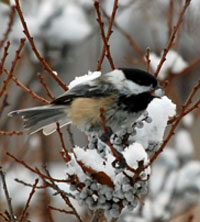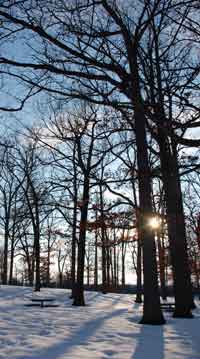 | Chickadee eating a bayberry (Myrica pensylvanica)
(Not the same as barberry!
Bayberries are very nutritious berries for birds.
|
Bread is not bird food
Ecosystem Gardening's Carole Brown makes a good point: Bread is NOT bird food. Here's why:
Bread products (including old bagels, doughnuts and the like) aren't nutritious for birds, especially at a time of year when they need good nutrition to make it through the winter.
Moldy products (often the ones thrown out to the birds) are especially dangerous. And even if they don't start out moldy, they can mold quickly when they're wet.
We wholeheartedly agree with her "better idea": plant native plants to supply bird food!
Read more...
|
|
Featured plant: Hawthorn
 | 'Winter King' hawthorn
(C. viridis)
Photo from Wikipedia: Scott Zona
|
The November Wild Ones conference was held at Connecticut College, which has a beautiful arboretum--indeed, the whole campus cherishes all its many trees.
One of the most noticeable trees we saw in the Arboretum was the hawthorn (Crataegus). It was noticeable because, in addition to the colorful berries, there were flocks of robins gorging on the fruit. If we had been there in the spring, we would have seen clouds of white flowers.
Hawthorns not only provide berries for birds, but their leaves host the many butterfly and moth larvae (which themselves are also excellent bird food), including the spectacular cecropia moth.
Carolyn Summers in Designing Gardens with Flora of the American East notes that because of their dense branching structure, they're also preferred nesting sites for many birds. She lists hawthorn as a good alternative to use instead of the non-native Kousa dogwood (Cornus kousa).
As its name implies, many hawthorns do indeed have thorns. This could be a problem if it's in a location where people will be in close contact with the tree.
Some cultivars have few thorns, though. In fact, William Cullina in his book Native Trees, Shrubs and Vines says that in the home landscape, the hawthorn is one plant where it may be wise to look for cultivars since in addition to having few thorns, they have fewer disease problems. (He generally favors seed-grown species for greater genetic diversity.)
Donald Leopold, in his book Native Plants of the Northeast notes that Washington hawthorn (C. phaenopyrum) is one of the most attractive native hawthorns in flower, foliage, and fruit.
'Winter King,' a cultivar of green hawthorn (C. viridis), has won many awards and is the most commonly available hawthorn.
Hawthorns aren't fussy as to moisture: they'll grow in dry to moist locations. They prefer a sunny location. Depending on the variety, they'll reach a height of 25' to 35' and almost as wide.
Yes, hawthorns may have some challenges, but they're truly spectacular and an excellent habitat plant.
|
 | | Burnet Park |
Boost winter happiness and energy
New research shows that being in nature and having contact with nature can improve vitality, increase physical activity and generate mental clarity.
When you have a habitat garden, there's something interesting going on all the time, reconnecting you to the natural world. We're also blessed with many beautiful parks to enjoy.
Read more...
|